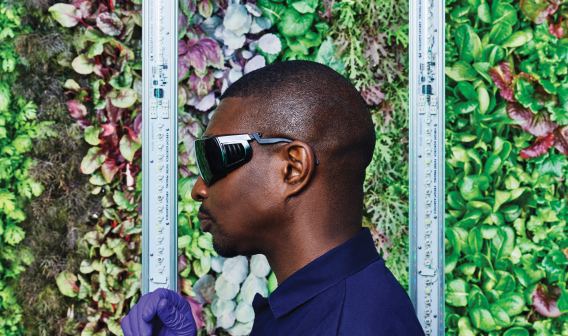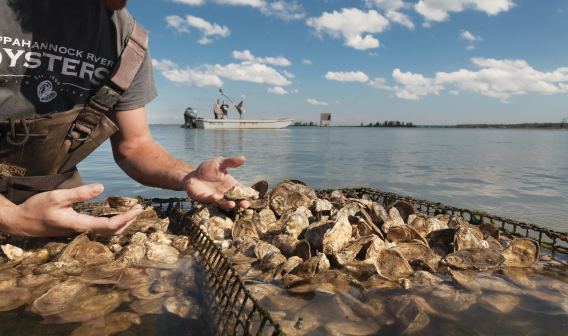The Future of Food
CEA companies bring food production to the people
Just outside the city of Danville, Virginia, sits a farm unlike any of its neighbors. Tucked into the tree line, it stands 50 feet high, sleek, and solid white, standing out from the long, thin rows of tilled fields that surround it.
Growth at AeroFarms happens entirely within this massive white warehouse. Inside, 48 growing towers glow with LED bulbs and reach as high as the five-story ceiling. Layer upon layer of vegetables mature under the targeted light spectrum. Their bare roots dangle, spritzed with precise amounts of water and nutrients for days or weeks, until they slide along a conveyor to be automatically harvested, packaged, and loaded onto a truck headed for Walmart, Amazon, or Whole Foods customers.
There are no seasons, no droughts, nor even any soil at AeroFarms. The company uses vertical farming — a combination of aeroponics and LED lighting — to control every input each plant needs. AeroFarms is just one of many innovators using technology to bypass the challenges of traditional agriculture, part of a new generation of growers working to secure the food supply and bring it as close to the people as possible.
A Technique With Ancient Roots
Controlled environment agriculture (CEA) dates at least as far back as the early years of the Roman Empire, when Emperor Tiberius demanded a more consistent supply of cucumbers. Moveable beds were placed outside in favorable weather and brought indoors in poor weather. Greenhouses have been used for millennia to nurture vulnerable plants. Even hoop houses, which use a simple plastic covering to protect plants and extend the growing season, are considered a type of CEA.
But in the last 20 years, indoor growing has taken on a new level of sophistication. Two camps have emerged: high-tech greenhouses and vertical farms.
Greenhouses have evolved well beyond capturing sunlight and shielding against weather. New high-tech greenhouses use supplemental light when necessary, harvest using robotics, and collect enormous amounts of data at the plant level. Gotham Greens, a high-tech greenhouse grower with 13 urban locations, uses machine learning to monitor crop health.
Other companies, like Bowery Farms in New Jersey, don’t use sunlight at all. Like AeroFarms, they’re vertical farms using all LED light. They also don’t use soil. Bowery employs hydroponics, where plant roots rest in water, while at AeroFarms, the plants’ roots are misted with water and nutrients in a process known as aeroponics.
Regardless of method, CEA is poised to expand. According to Market.us research, the CEA market — from hoop houses to vertical farms — was valued at $74.4 billion in 2021 and is projected to more than triple by 2032. According to the report, areas like automation, lighting, and analytics hold the most opportunities for growth.
The UN thinks that by 2050, there will be nearly 10 billion people to feed. That’s 25% more food with fewer resources with more volatility.
Maximizing Yield by Minimizing Variability
Success in the produce industry largely comes down to a grower’s ability to predict the future — an area where indoor growers have the upper hand. Traditional growers must anticipate loss due to inclement weather, pests, and food wasted in the field. The amount a grower plants doesn’t always translate perfectly to yield, and harvest timing can vary by weeks, depending on the weather.
Indoor growers, on the other hand, can predict the harvest window down to the day. And their percent yield is higher because they have more control over light and nutrients. At AeroFarms, leafy greens that traditionally take 35 to 40 days to harvest can be grown in 12 to 14 days.
These companies can produce more food in a shorter window by circumventing the variability of nature — and they can do so with fewer inputs. Precise delivery of water, nutrients, and fertilizer means less is wasted.
“The UN thinks that by 2050, there will be nearly 10 billion people to feed. That’s 25% more food with fewer resources with more volatility,” said Kate Seawell, chief commercial officer at Bowery. Indoor methods offer an opportunity to meet the needs of this moment, she added.
Indoor growers also enjoy the ability to bring production closer to consumers. In 2020, 77% of the U.S.’s fresh fruit and vegetables came from Mexico. Mexican produce can take up to two weeks to arrive at grocers, while CEA farms, with smaller physical footprints, can be located closer to major population centers, reducing the time from harvest to shelf.
Shorter Journeys Enable Higher Quality
Because of their proximity to grocers and consumers, indoor growers can also focus on a virtue of vegetables that’s often deemphasized: taste.
Many vegetable varieties have been prioritized for their ability to withstand the long journey from harvest to shelf. Tomatoes and cucumbers are bred so they won’t wither or rot in the weeks required for harvest and travel to far-flung destinations. Growers then run into an unfortunate reality: If you’re breeding for hardiness, you’re breeding against taste.
Indoor growers able to locate in or near major cities and foodways aren’t so confined. With less distance to cover, these companies can afford to expand production to other crops, including varieties that are more delicate and others bred for optimal taste.
Indoor growing seems to offer the ideal scenario — higher yields of better-tasting foods, using fewer resources. But one factor stands in the way of faster expansion: cost.
Between land needs, building costs, extensive energy needs, and the use of cutting-edge technology, indoor growing is capital-intensive. One supplier quoted its vertical farming technology at $1,000 per square meter. That’s on top of research and development as companies work to develop their own proprietary growing methods for different plant varieties.
After a large initial round of CEA investment, focus has shifted to getting companies to scale to produce a profit. Lux Research analysts note that many indoor growers “still [have] a long road ahead to matching the costs of produce grown outdoors as well as the crop diversity.” To get there, energy efficiency and a knowledgeable workforce are crucial, and growers are investing in programs and partnerships aimed at those goals.
Climate change and geopolitical unrest have provided massive tailwinds for the CEA sector, Seawell explained. Moving forward, there’s room for a variety of innovations and indoor growing models. She said, ultimately, everyone is moving toward the same end, “working to crack the code on how to fortify and strengthen the food system.”





